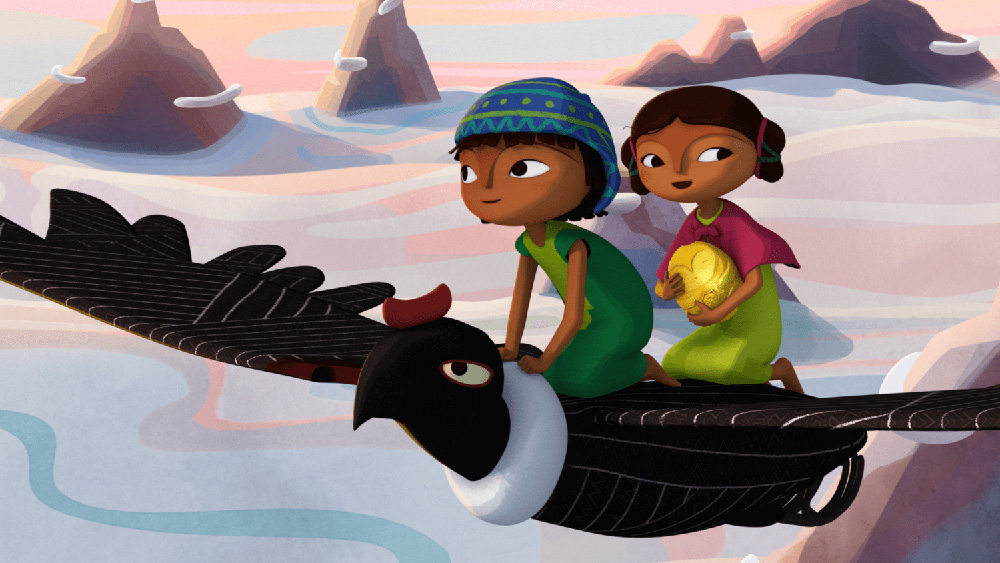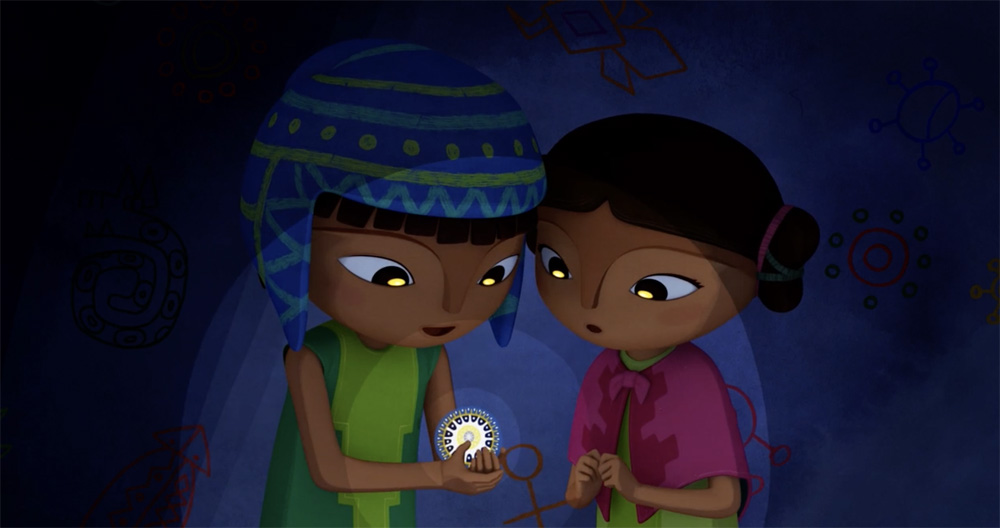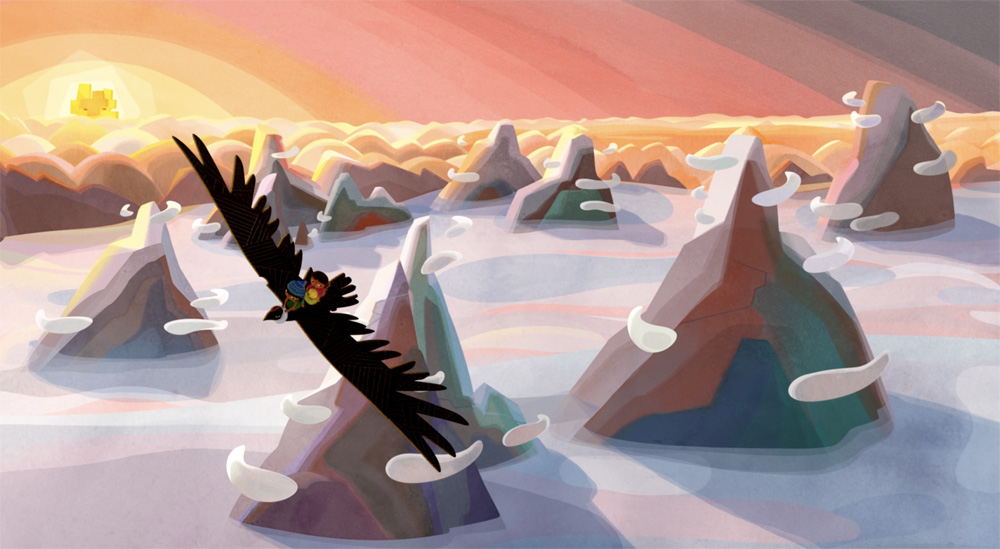Last year, French animation studio Folivari produced a beautiful CG/2D animated feature about a young boy living in a remote village in the Andes mountains who dreams of being a shaman. Directed by Argentine helmer Juan Antin, this co-pro between France, Canada and Luxembourg received great word of mouth, and will debut this Friday on Netflix. We had a chance to interview Antin via email, and here is what he kindly shared with us about his lovely, César-nominated film:
Can you tell us when you conceived of the project, and when you actually started working on it? How long did it take to complete?
Juan Antin: I started thinking about Pachamama after finishing my first film, Mercano the Martian, back in 2004. It took me a few years of research and travels on the Andean region of northern Argentina, Bolivia and Peru. I started writing the story, but at that time, I was imagining it as a stop-motion film. I even shot a teaser, but then I was delayed by difficulties on the funding of the project. In Argentina, after the economic crisis, it got difficult to make such an ambitious project. I moved to France to coproduce it there and, with some ups and downs, I was finally able to start production on 2015 at Folivari, Didier Brunner’s studio. Finishing in 2018, it took me 14 years to go from the idea to the screen. My next film will come a lot faster, I promise!

Where was the bulk of the animation done, and how many people worked on the movie?
Pachamama is a mixed 3D/2D film and because of its quite complex international co-production pipeline, we had the team scattered over two continents and three countries (France, Luxembourg and Canada). All the 3D character animation was done in Montreal, the color backgrounds and 2D effects were made in Luxembourg, and all pre-production, design, modelling and compositing was made in France. Everything was coordinated from our headquarters in Paris. In total, the team was more than a hundred people.
How was the animation produced?
We only used 2D animation (hand drawn) for the special effects like water, fire, smoke, etc. All character animation was done in 3D, but I briefed the animators to make it quite minimalistic, more like if they were animating in stop motion — that is, without a lot of interpolation between keyframes, to avoid that 3D look. At first everybody was concerned that it could look too rough, but the result is very expressive and gives Pachamama a quite original style.

Can you tell us a little about the ecological theme of the movie and what it means to you?
In Quechua, the language of the Incas, “Pachamama” means Mother Earth. More than that, the indigenous cultures consider human beings, along with all animals and plants, to be part of the Earth itself, all together like a huge living organism. I think that this is a beautiful way to see nature, so the whole concept of the film — not just narrative, but also graphical — is based on that idea.
But with this ecological theme I didn’t want to make it very conceptual, explaining too much, being too didactic. That would have been boring and ultimately I think that those ideas and concepts don’t get to small children. I wanted the film to be more like a feeling, working on the emotional level more than on the intellectual. The story is very simple and that gives the opportunity to let go and get in a contemplative state, where rhythm, colors and music help to bring out positive feelings and emotions.
Music plays a huge role in the movie. Can you talk a little bit about it and how you chose the composer, and how you worked together?
From the very beginning, I imagined music that will get the audience immersed into the pre-Columbian Andean world, using only the few elements available in that ancient time: winds, percussion and pentatonic scales, keeping it very natural, atmospheric and minimalistic. And then, with the arrival of the Conquistadors in the film, the music would completely change its style to become European Renaissance music with all those new powerful instruments that came from the Old World (guitars, violins, cellos, brass, etc.) It was for me like a musical metaphor of the Conquest, and the score would have to be a dialogue between those two different styles of music, representing this clash of the cultures.
This concept was interesting, but I had no clue who would be able to do that…
But here’s where the magic comes in: after moving near Paris to start production, I met (in a ridiculously haphazard way…) Pierre Hamon (he was my neighbor!), who is a musician and ethnomusicologist, expert in ancient European music and… he was passionate about pre-Columbian music! He was in possession of some two-thousand-year-old ceramic flutes from Ancient Peru and the minute we’ve met, before telling him anything, he started to play those ancient flutes and to make rhythms with condor’s feathers! I was shocked and couldn’t speak, and left his house sure that I’ve found the composer of Pachamama. For Pierre it was a huge challenge to compose a score that could touch the emotion of today’s audience with such minimal elements, that is without chords, without known western harmonies, but he got inspired by those ancient instruments and wrote music that is completely magical, profound and with melodies that go along beautifully with the images.

Who are some of your animation idols?
I love the classic animators in general, especially Eastern European animators like the Czech Jiri Trnca and Jan Svankmajer. But also I’m a big fan of Ray Harryhausen, Lotte Reiniger and also some modern animators like Hayao Miyazaki, Michel Ocelot, Isao Takahata, Nick Park — the list could go on and on…
What were some of the visual inspirations and influences for the movie?
To create the world of Pachamama, the idea was to base all the graphics on pre-Columbian Andean art, trying to immerse the audience in a different and truly authentic world built upon very simple elements like patterns, Andean designs and vibrant colors. For this, I worked with visual artist and anthropologist María Hellemeyer, who created the very basis of the graphic universe of Pachamama. For the characters, the inspiration came mostly from pottery. We used to look at those vases and see very funny characters, they are simple yet powerful and very expressive. And for the backgrounds, we based them on Andean patterns like those found on textiles and pottery. They are very geometrical and repetitive designs that have a powerful effect.
What would you say was the most important lesson you learned through the making of the film?
Everything that happens in the process is just perfect for the finished film, even what you think to be bad things. It all makes sense in the end.
What was the toughest challenge of making the movie?
I think the toughest part was finding the financing to be able to start production. Pachamama is a quite unusual film and I had to knock at many doors before finding the right partners, willing to take risks of producing something different. Also, I would say that the production in itself was very tough as we had the team scattered on three different countries, with different time zones. We had also some budgetary constraints, and that was overall quite stressful and very challenging.

When did you realize that you wanted to work in animation?
Well, animation is a mixture of so many things I love: storytelling, visual arts, music, acting, cinema and also physics and computer science… I don’t know exactly when was the first time I wanted to do animation but I can tell you that when I was a kid, I used to watch the Harryhausen films with those animated sequences (like the skeletons fighting Jason) and it was completely mindblowing for me. I confess that that state of wonder still happens to me when I do an animation and then see it coming alive.
What is your take on the global animation scene in 2019?
It’s pretty exciting to see how many good quality films are done or being made this year and over the last years. It’s amazing because some years ago we had just one or two films per year, coming out from the same people. But there was some kind of democratization, and this gave opportunities to new things, different points of view, new voices to come out.
What do you hope audiences will take from your movie?
There are lots of things coming out from Pachamama. First comes, of course, the ecological aspect, but there is also a cultural dimension. I would like audiences to discover the beautiful ancient cultures of America, not just the Incas but our whole continent was flourishing with awesome civilizations, and see how they were amazing and advanced so in many ways.
What kind of advice would you give up-and-coming artists who want to direct their own animated movie?
Never give up, even during the bad times, when you think your project is dead, keep on fighting, because it’s your energy that creates opportunities.
Pachamama premieres on Netflix on Friday, June 7.






 Win a Funko X Lilo & Stitch Prize Pack!
Win a Funko X Lilo & Stitch Prize Pack! 
